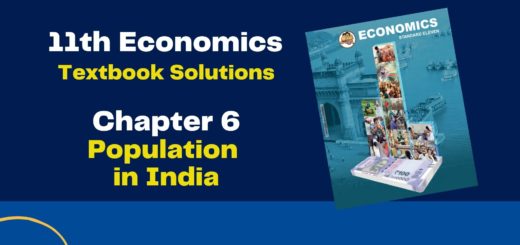12th Economics Chapter 7 Solutions (National Income) Maharashtra Board – Free Solution
Table of Contents
12th Economics Chapter 7 Solutions

Chapter 7 – National Income
Q. 1. Complete the following statements
1) While estimating national income, we include only value of final goods and services in order to ………
a) make computation easier
b) avoid double counting
c) maximize national welfare of the people
d) evaluate the total economic performance of a nation
2) NDP is obtained by ……….
a) deducting depreciation from GNP
b) deducting depreciation from GDP
c) including depreciation in GDP
d) including depreciation in GNP
3) In India, national income is estimated using ………..
a) output method
b) income method
c) expenditure method
d) combination of output and income method
Q. 2. Complete the Correlation
1) GDP : C + I + G + (X-M) : : GNP : C + I + G + (X-M) + (R-P).
2) Output method : Inventory Method : : Income method : Factor cost method
3) Theoretical difficulty : Transfer payments : : Practical difficulty : Valuation of Inventories
Q. 3. Choose the correct option
1) Wrongly matched pair :
a) National Income Committee: 1949
b) Financial year: 1st April to 31st March
c) Income method : National Income = Rent+Wages+Interest+Profit+Mixed income+Net Income from abroad
d) Expenditure method : National Income = Rent + Wages + Interest + Profit
Options: 1) a 2) b 3) c 4) d
Answer: 4) d
Solution of other subjects
Solution of all Chapters of Economics
1 – 2 – 3A – 3B – 4 – 5 – 6 – 7 – 8 – 9 – 10
Q. 4. Identify and Explain the following concepts
1) Vrinda receives a monthly pension of Rs.5,000/- from the State Government.
Identified Concept: Transfer Income
Explanation: Transfer income refers to the income received without rendering any productive service in return. Transfer income refers to the income received without rendering any productive service in return.
2) Viru kept aside 100 kgs. out of 500 kgs. of wheat produced in his farm for his family.
Identified Concept: Self-consumption
Explanation: The product for self-consumption is the part of the product that is set aside to meet the needs of self and family.
3) Sheetal purchased wheat flour for her bakery from the flour mill.
Identified Concept: Intermediate goods.
Explanation: An intermediate good is a product used to produce a final good or finished product—also referred to as a consumer good.
4) Shobha collected data regarding the money value of all final goods and services produced in the country for the financial year 2018-2019.
Identified Concept: National Income
Explanation: In real terms, national income is the flow of goods and services produced in an economy during a year.
5) Rajendra has a total stock of 500 gel pens in his shop which includes the 200 gel pens produced in the previous financial year.
Identified Concept: Inventory
Explanation: A company always has some stock lying with them. The stock can be of finished goods or raw materials or semi-finished goods. This stock of materials is what we refer to as inventory.
Solution of other subjects
Solution of all Chapters of Economics
1 – 2 – 3A – 3B – 4 – 5 – 6 – 7 – 8 – 9 – 10
Q.5. Answer the following
1) Explain the two sector model of circular flow of national income.
Answer: Circular flow of income is the basic concept in macroeconomics. The circular flow of income refers to the process whereby an economy’s money receipts and payments flow in a circular manner continuously through time.
The circular flow of goods and money in a two-sector model is explained below:
1) Two sector Economy (Households and Business Firms.) Y = C + I
2) There are two sectors, households and firms. It divides the diagram into two parts. The upper half represents the factor market and the lower half represents the commodity market.
3) Below fig. explains the circular flow of income and expenditure in a two-sector model.
4) In the above figure, the factors of production flow from the households to the firms. The firms use these factors to produce goods and services required by the households. Thus, goods flow from the households to the firms and from the firms back to the households. It is called product flows.
5) In the same way, money flows from the firms to the households in the form of factor payments such as rent, wages, interest, and profit. Households use this income to purchase goods and services. Thus, money flows from the firms to the households and from the households back to the firms. It is called money flows.
6) In the circular flow of income, production generates factor income, which is converted into expenditure. This flow of income continues as production is a continuous activity due to never-ending human wants. It makes the flow of income circular
2) Explain the importance of national income.
.Answer: The total income of the nation is called national income.
The following points explain the importance of the National Income
1) Useful for the Economy:
National income data are important for the economy of a country. In present times, the national income data are regarded as accounts of the economy, which are known as ‘Social Accounts’. It tells us how the aggregates of a nation’s income, output, and product result from the income of different individuals, products of industries and transactions of international trade.
2) National policies:
National income data forms the basis of national policies such as employment policy, industrial policy, agricultural policy, etc. These figures enable us to know the direction in which the industrial output, investment, and saving, etc., change.
3) Economic planning:
For economic planning, data pertaining to national income is very essential. This includes data related to a country’s gross income, output, savings, investment and consumption which can be obtained from different sources.
4) Economic Research:
National income data are also used by the research scholars of economics. They make use of various data of the country’s input, output, income, savings, consumption, investment employment etc., which are obtained from social accounts.
5) Comparison of Standard of Living:
National income data helps us to compare the standards of living of people in different countries and of people living in the same country at different times.
6) Distribution of Income:
National income statistics enable us to know about the distribution of income in the country from the data related to wages, rent, interest, and profits. We understand the disparities in the incomes of different sections of society.
3) Explain the features of national income.
Answer: The total income of the nation is called national income.
1) Macro Economic concept:
National income represents the income of the economy as a whole rather than that of an individual. Hence it is a macroeconomic concept.
2) Value of only final goods and services:
In order to avoid double-counting in national income, the value of only final goods and services produced in the economy are considered. The value of intermediate goods or raw materials is not considered. For example, while estimating the production of shirts, there is no need to take the value of cotton, as it is already included in the price of the shirts.
3) Net aggregate value:
National income includes net value of goods and services produced and does not include depreciation cost. (i.e. wear and tear of capital assets)
4) Net income from abroad:
National income includes net income from abroad i.e. difference between export value and import value (X-M) and net difference between receipts from abroad and payments made abroad (R-P).
5) Financial year:
National income is always expressed with reference to a time period. In India, it is from 1st April to 31st March.
6) Flow concept:
National income is a flow concept as it shows a flow of goods and services produced in the economy during a
year.
7) Money value:
National income is always expressed in monetary terms. It represents only those goods and services which are
exchanged for money.
4) Explain the concept of Green GNP.
Answer: a) Green GNP is an indicator of sustainable use of the natural environment and equitable distribution of benefits of development.
b) Gross National Product does not take into consideration the cost in terms of
(i) Environmental pollution, (ii) Depletion of natural resources caused by the production of output.
c) Mere increase in GNP will not reflect improvement in quality of life when it increases environmental pollution or reduces available resources for future generations.
So Green GNP has been introduced while measuring economic welfare.
Measurement :
Green GNP = GNP – (Net fall in stock of natural capital + pollution load.)
Following are the characteristics of Green GNP
1) Sustainable economic development, i.e. development that should not cause environmental degradation (pollution) and depletion of natural resources.
2) Equitable distribution of benefits of its development.
3) Promotes economic welfare for a long period of time.
Q.6. State with reasons whether you agree or disagree with the following statement
1) There are many theoretical difficulties in the measurement of national income.
Ans: Yes, I agree with this statement.
Reason:
a) Transfer payments:
Individuals get pension, unemployment allowance etc. but whether these transfer payments should be included in national income or not, is a major problem.
b) Illegal income:
Illegal incomes like income from gambling, black marketing, theft, smuggling etc. are not included in national income.
c) Production for self-consumption:
The products kept for self-consumption by the farmers and other allied producers do not enter the market. Hence, it is not accounted for in the National Income.
d) Income of foreign firms:
According to IMF, income of a foreign firm, should be included in the national income of the country, where the firm actually undertakes the production work.
Hence, there are many theoretical difficulties in the measurement of national income.
2) Under the output method, the value-added approach is used to avoid double counting.
Ans: Yes, I agree with this statement.
Reason: a) According to this approach, the value added at each stage of the production process is included.
b) The difference between the value of final outputs and inputs, at each stage of production is called the value-added.
c) Thus, GNP is obtained as the total of the values added by all the different, stages of the production process, till the final output is reached in the hands of consumers, to meet the final demand.
d) Therefore, To avoid double-counting value-added approach is used.
Solution of other subjects
Solution of all Chapters of Economics
1 – 2 – 3A – 3B – 4 – 5 – 6 – 7 – 8 – 9 – 10
Q.7. Answer in detail
1) Explain the practical difficulties involved in the measurement of national income.
Answer: The total income of the nation is called national income. In real terms, national income is the flow
of goods and services produced in an economy during a year.
Theoretical Difficulties or Conceptual Difficulties: In practice, several difficulties arise in the collection of statistical data required for estimation of national income. Some of the practical difficulties are as follows:
1) Problem of double counting:
The greatest difficulty in calculating national income is of double counting. It arises from the failure to distinguish properly, between a final and an intermediate product. For example, flour used by a bakery is an intermediate product and that by a household is final product.
2) Existence of non-monetized sector:
In India, especially in rural areas, there exists the non-monetized sector. Agriculture, still being in the nature of subsistence farming, a major part of production is partly exchanged for other goods and services. It is excluded while counting national income.
3) Inadequate and unreliable data:
Adequate and correct data on production and cost data relating to crops, fisheries, animal husbandry, forestry, construction workers, small enterprises etc., are not available in a developing country. Besides this, data on unearned incomes, consumption and investment expenditure of rural and urban population are also not available. This does not reveal the actual size of national income.
4) Depreciation:
Depreciation refers to wear and tear of capital assets, due to their use in the process of production. There are no uniform, common or accepted standard rates of depreciation applicable to the various capital assets. Thus, it is difficult to make correct deductions for depreciation.
5) Capital gains or losses:
Capital gains or capital losses, which accrue to the property owners by increase or decrease in the market value of their capital assets or changes in demand, are not included in the national income because these changes do not result from current economic activities.
6) Illiteracy and ignorance:
Due to ignorance and illiteracy, small producers do not keep an account of their production. So they cannot give information about the quantity or value of their output.
7) Difficulties in the classification of working population:
In India, working population is not clearly defined. For instance, farmers in India are not engaged in agriculture round the year. Obviously, in the off season, they engage themselves in alternative occupations. In such a case, it is very difficult to identify their income from a particular occupation.
8) Valuation of inventories:
Raw materials, intermediate goods, semi-finished and finished products in the stock of the producers are known as inventories. Any mistake in measuring the value of inventory will distort the value of the final production of the producer. Therefore, the valuation of inventories requires careful assessment.
2) Explain the income method and expenditure method of measuring national income.
Answer: The total income of the nation is called national income. In real terms, national income is the flow
of goods and services produced in an economy during a year.
Methods of Measurement of National Income :
There are three methods of measuring national income.
1) Output Method/Product Method
2) Income Method
3) Expenditure Method
1) Income Method:
a) This method of measuring national income is also known as factor cost method. This method estimates national income from the distribution side.
b) According to this method, the income payments received by all citizens of a country, in a particular year, are added up, that is, incomes that accrue to all factors of production by way of rents, wages, interest and profits are all added together, but income received in the form of transfer payments are ignored.
c) The data about income are obtained from different sources, for instance, from income tax returns, reports, books of accounts, as well as estimates for small income.
d) GNP can be treated as the sum of factor incomes, earned as a result of undertaking economic activity, on the part of resource owners and reflected in the production of the total output of goods and services during any given time period.
e) Thus, GNP, according to income method, is calculated as follows:
NI = Rent + Wages + Interest + Profit + Mixed Income + Net income from abroad.
NI = R + W + I + P + MI + (X–M)
f) In India, the National Income Committee of the Central Statistical Organization, uses the income method for adding up the income arising from trade, transport, professional and liberal arts, public administration and domestic services.
2) Expenditure Method:
a) This method of measuring national income is also known as Outlay Method.
b) According to this method, the total expenditure incurred by the society, in a particular year, is added together. Income can be spent either on consumer goods or on capital goods.
c) Thus, we can get national income by summing up all consumption expenditure and investment expenditure made by all individuals, firms as well as the government of a country during a year.
d) Gross national product is found by adding up
NI = C + I + G + (X–M) + (R–P)
i) Private Final Consumption Expenditure (C):
Private Final Consumption Expenditure (C) by households on non-durable goods, such as food, which are used immediately; expenditure on durable goods such as cars, computers, television sets, washing machines, etc., which are generally used for a longer period; and expenditure on services like transport services, medical services, etc.
ii) Gross Domestic Private Investment Expenditure (I):
It refers to expenditure made by private businesses on replacement, renewals and new investment (I).
iii) Government Final Consumption and Investment Expenditure (G):
a) The government’s final consumption expenditure refers to the expenditure incurred by government on various
administrative services like law and order, defence, education, health, etc.
b) Government’s investment expenditure refers to the expenditure incurred by government, on creating infrastructural facilities like construction of roads, railways, bridges, dams, and canals, which are used by the
business sector for production of goods and services in any economy (G).
iv) Net Foreign Investment/Net Exports:
It refers to the difference between a country’s exports and imports during one year.
v) Net Receipts (R-P):
The difference between expenditure incurred by foreigners on domestic goods and services (R) and expenditure incurred abroad by residents on foreign goods and services (P).
Extra Questions
Answer the following questions.
1) Explain the Concept of Balance of payments.
Answer:
a) The Balance of payments of a country is a systematic record of all international economic transactions of that country during a given period, usually a year.
b) According to Ellsworth, “Balance of payments is a summary statement of all the transactions between the residents of one country and the rest of the world.
c) According to Walter Krause, “The balance of payments of a country is a systematic record of all economic transactions completed between its residents and the rest of the world during a given period of time usually a concept of the year.
d) From the above definitions, it is clear that the value of exchange of goods and services among the citizens, businessmen, firms, government, etc. is included in balance of payments
2) Explain Balance of Trade.
Answer:
a) Balance of trade is the difference between the value of a country’s exports and imports for a given period.
b) Balance of trade is also referred to as the international trade balance.
c) According to Bentham,“Balance of trade of a country is the relation over a period between the values of her exports and imports of physical goods.”
d) According to Samuelson, “if the export value is greater than the import value it is called as trade surplus and if import value is greater than export value, then it is called as trade deficit.”
e) It is clear from the above definitions that balance of trade includes the value of imports and exports of visible goods and invisible goods.
Solution of other subjects
Solution of all Chapters of Economics
1 – 2 – 3A – 3B – 4 – 5 – 6 – 7 – 8 – 9 – 10
Solution of all Chapters of Economics
| Chapter Name | Solution Link |
| 1) Introduction to Micro and Macro Economics | Click Here |
| 2) Utility Analysis | Click Here |
| 3A) Demand Analysis | Click Here |
| 3B) Elasticity of Demand | Click Here |
| 4) Supply Analysis | Click Here |
| 5) Forms of Market | Click Here |
| 6) Index Numbers | Click Here |
| 7) National Income | Click Here |
| 8) Public Finance in India | Click Here |
| 9) Money Market and Capital Market in India | Click Here |
| 10) Foreign Trade of India | Click Here |
Check out other posts related to the 12th Commerce
| Textbook Solutions of 12th Commerce (All Subjects) | Click Here |
| Free pdf of 12th Commerce Textbooks | Click Here |
| 12th Commerce IT MCQ Preparation (Online Test) | Click Here |
| 12th Commerce Paper Pattern and Chapter Wise Marks Distribution | Click Here |
| Sample Paper of 12th Commerce for Practice | Click Here |
| Solved Sample papers of 12th Commerce to improve Paper Presentation | Click Here |
| Old Question Papers of 12th Commerce with solution (All Subjects) | Click Here |


